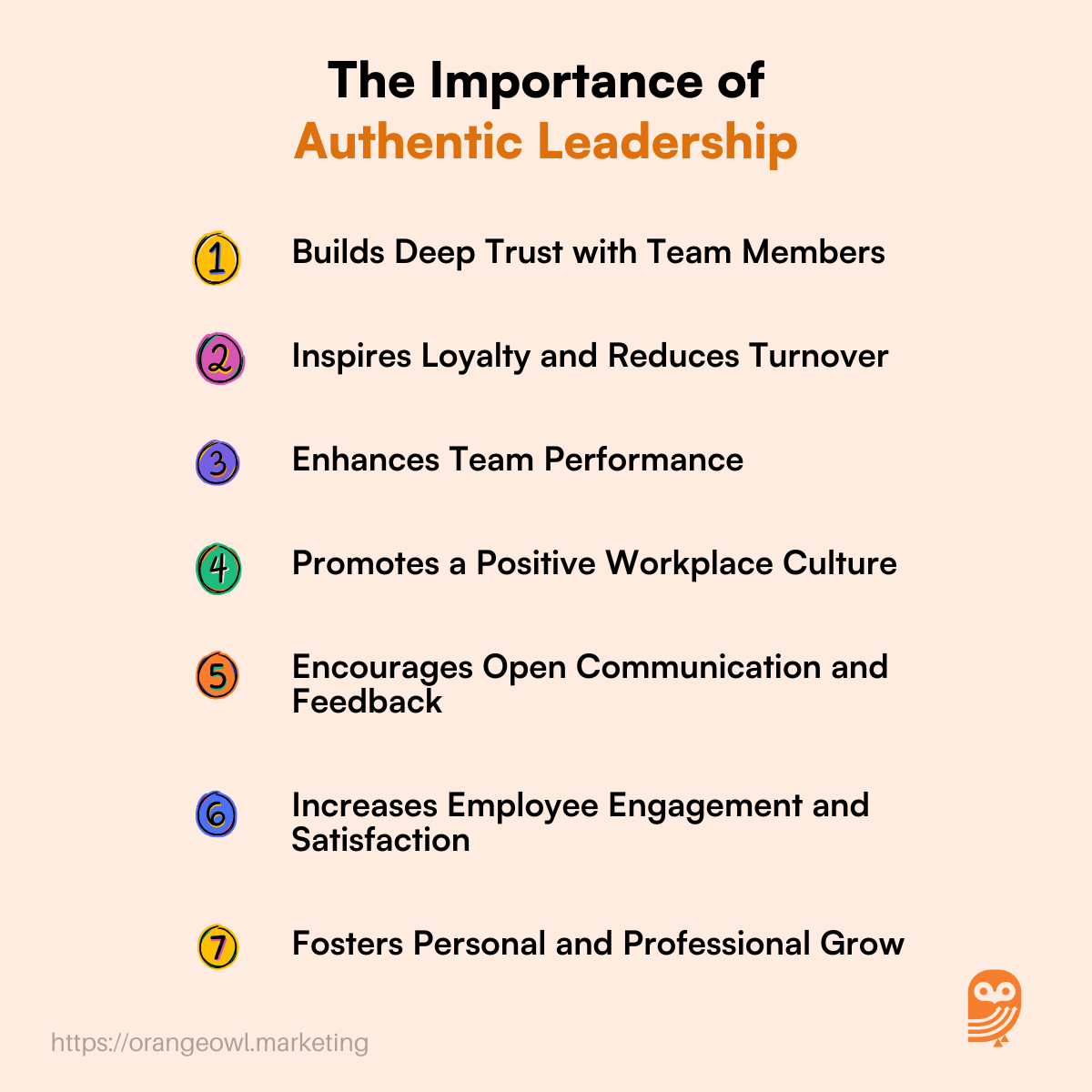The Importance of Authentic Leadership
Here are seven key benefits of building authentic leadership, each with examples to illustrate its impact:
1. Builds Deep Trust with Team Members
Benefit: Authentic leaders create an environment of trust, where team members feel safe and valued. Trust fosters open communication and collaboration, leading to a more cohesive and motivated team.
Example: Imagine a leader who is transparent about challenges facing the organization, sharing potential impacts with the team rather than hiding them. This honesty strengthens team loyalty and commitment because employees feel respected and valued as part of the bigger picture.
2. Inspires Loyalty and Reduces Turnover
Benefit: When leaders act with integrity, employees are more likely to stay loyal. Authentic leaders build a culture where people want to stay, reducing turnover and boosting long-term productivity.
Example: A manager who genuinely cares about their team’s well-being, allowing flexible schedules or work-from-home options when needed, often retains employees longer. This understanding approach makes team members feel supported and valued, reducing the likelihood of them seeking work elsewhere.

3. Enhances Team Performance
Benefit: Authentic leadership encourages employees to be themselves, fostering a supportive environment where team members can take risks, innovate, and perform at their best.
Example: Imagine a leader who regularly asks for feedback and listens actively. By implementing team suggestions and recognizing contributions, they inspire team members to perform at their best. This openness encourages creativity and innovation, directly boosting productivity.
4. Promotes a Positive Workplace Culture
Benefit: Authentic leaders model positive behaviors and set the tone for a culture of respect, integrity, and inclusivity. This creates a workplace where people are happy to contribute and collaborate.
Example: A leader who acknowledges each team member’s unique strengths and encourages their development fosters a positive culture. For instance, a leader who organizes monthly team-building activities reinforces a sense of belonging and inclusivity, making the workplace feel like a supportive community.
5. Encourages Open Communication and Feedback
Benefit: Authentic leaders prioritize honest communication, creating an atmosphere where feedback flows freely. This openness helps identify and solve problems quickly, keeping projects and relationships on track.
Example: A leader might hold weekly “feedback sessions” where team members can raise concerns or share ideas without judgment. This encourages proactive communication, allowing the team to adjust strategies before problems escalate and showing that the leader values each voice.
6. Increases Employee Engagement and Satisfaction
Benefit: When employees see a leader acting consistently with their words and values, they are more engaged and find greater satisfaction in their roles. Authentic leadership fuels a sense of purpose and motivation.
Example: A leader who regularly communicates the company’s mission and values, tying them to everyday work, creates a deeper sense of purpose. Employees understand how their efforts contribute to the bigger picture, making them more motivated and satisfied in their roles.
7. Fosters Personal and Professional Growth
Benefit: Authentic leaders encourage growth, helping employees develop their skills and expand their potential. This benefits both the team and the individual, increasing overall effectiveness.
Example: Consider a leader who not only provides constructive feedback but also offers opportunities for professional development, like workshops or courses. This investment in growth shows employees that their development is valued, creating a team that continuously improves and feels valued.
Building Authentic Leadership: A Step-by-Step Guide
Here’s how to build a foundation for authentic leadership, with actionable steps, examples, and a guide to avoid common pitfalls.
1. Define and Communicate Core Values
Step: Start by identifying core values that guide decision-making. Leaders who clearly articulate and live by their values create a solid foundation for trust and alignment.
Example: Suppose a leader values sustainability. They openly discuss adopting eco-friendly practices, integrating these principles into both product and operations. By consistently communicating this commitment, the team knows what the organization stands for, helping align their own efforts.
Common Mistake: Preaching values but not practicing them can create a disconnect. Leaders must embody these values daily to maintain credibility.
2. Encourage Open Communication
Step: Authentic leaders foster a culture of transparency by encouraging open dialogue, making team members feel valued and respected.
Example: Imagine a leader implementing regular “open office hours” for team members to voice challenges or share ideas. This open-door approach fosters trust and inclusivity, reinforcing that every voice matters.
Common Mistake: Shutting down differing opinions or selectively addressing feedback can harm morale. Leaders should consistently encourage dialogue, even when opinions diverge from their own.
3. Model Transparency in Decision-Making
Step: Authentic leaders don’t make decisions in isolation. Instead, they provide insight into the decision-making process, bringing others along on the journey.
Example: Consider a company pivoting its product focus. A transparent leader would share the rationale—market trends, potential impacts, and goals—engaging team leads to get input. This transparency ensures alignment, respect, and collective accountability.
Common Mistake: Withholding key information out of fear of backlash or hesitation can foster mistrust. Transparent decisions, even challenging ones, strengthen alignment and respect.
4. Lead by Example
Step: The most effective leaders model the behaviors and values they wish to see. Consistency in action builds integrity and respect.
Example: If a leader values work-life balance, they demonstrate it by setting boundaries, taking time off, and respecting their team’s downtime. By leading through example, leaders set a standard that the entire team can aspire to.
Common Mistake: Inconsistency between what leaders say and do erodes credibility. Authentic leadership means “walking the talk” every day, especially in challenging times.
5. Show Vulnerability and Accept Accountability
Step: Authentic leaders are honest about mistakes and seek continuous improvement. Showing vulnerability and accepting responsibility builds trust.
Example: Picture a leader acknowledging a poor product rollout, sharing what went wrong, and actively involving the team in a solution. This level of transparency creates a resilient and supportive culture, where everyone feels empowered to learn and grow together.
Common Mistake: Deflecting responsibility damages trust. Leaders who embrace accountability foster a culture of mutual respect, encouraging others to do the same.
6. Invest in Personal and Team Growth
Step: Authentic leaders are committed to both their personal development and the growth of their teams, nurturing a culture of learning and evolution.
Example: Leaders attending workshops or conferences and sharing key insights show a dedication to improvement. This effort inspires team members to pursue their development actively, cultivating a learning environment.
Common Mistake: Prioritizing business metrics over personal growth can make leaders appear rigid. By embracing growth as a continuous process, leaders show they’re evolving alongside their teams.
Final Reflection:
Building an authentic leadership culture starts with consistency, integrity, and open communication. Leaders who remain true to their values create a workplace where loyalty and engagement thrive. Authenticity isn’t just a leadership strategy—it’s the cornerstone for meaningful connections and lasting success.
✅ “Discover the Leader’s Edge — Your Guide to Building Strong, Impactful Leadership”



